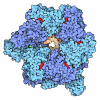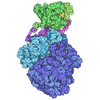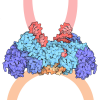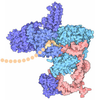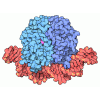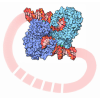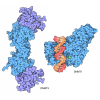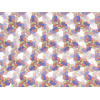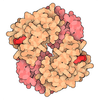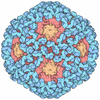+ Open data
Open data
- Basic information
Basic information
| Entry | Database: PDB / ID: 9j8w | ||||||||||||||||||||||||||||||||||||
|---|---|---|---|---|---|---|---|---|---|---|---|---|---|---|---|---|---|---|---|---|---|---|---|---|---|---|---|---|---|---|---|---|---|---|---|---|---|
| Title | Cryo-EM structure of NCP-UV-DDB complex containing CPD | ||||||||||||||||||||||||||||||||||||
 Components Components |
| ||||||||||||||||||||||||||||||||||||
 Keywords Keywords | DNA BINDING PROTEIN / DNA repair / Nucleosome / UV-DDB / DNA damage / DDB2 / NER | ||||||||||||||||||||||||||||||||||||
| Function / homology |  Function and homology information Function and homology informationUV-damage excision repair / Cul4A-RING E3 ubiquitin ligase complex / Cul4-RING E3 ubiquitin ligase complex / Cul4B-RING E3 ubiquitin ligase complex / site of DNA damage / pyrimidine dimer repair / negative regulation of tumor necrosis factor-mediated signaling pathway / response to UV / negative regulation of megakaryocyte differentiation / protein autoubiquitination ...UV-damage excision repair / Cul4A-RING E3 ubiquitin ligase complex / Cul4-RING E3 ubiquitin ligase complex / Cul4B-RING E3 ubiquitin ligase complex / site of DNA damage / pyrimidine dimer repair / negative regulation of tumor necrosis factor-mediated signaling pathway / response to UV / negative regulation of megakaryocyte differentiation / protein autoubiquitination / protein localization to CENP-A containing chromatin / Chromatin modifying enzymes / Replacement of protamines by nucleosomes in the male pronucleus / CENP-A containing nucleosome / Packaging Of Telomere Ends / Recognition and association of DNA glycosylase with site containing an affected purine / Cleavage of the damaged purine / Deposition of new CENPA-containing nucleosomes at the centromere / Recognition and association of DNA glycosylase with site containing an affected pyrimidine / Cleavage of the damaged pyrimidine / telomere organization / Interleukin-7 signaling / RNA Polymerase I Promoter Opening / Inhibition of DNA recombination at telomere / epigenetic regulation of gene expression / Meiotic synapsis / Assembly of the ORC complex at the origin of replication / SUMOylation of chromatin organization proteins / Regulation of endogenous retroelements by the Human Silencing Hub (HUSH) complex / DNA methylation / Condensation of Prophase Chromosomes / Chromatin modifications during the maternal to zygotic transition (MZT) / SIRT1 negatively regulates rRNA expression / HCMV Late Events / innate immune response in mucosa / ERCC6 (CSB) and EHMT2 (G9a) positively regulate rRNA expression / PRC2 methylates histones and DNA / Regulation of endogenous retroelements by KRAB-ZFP proteins / Defective pyroptosis / nucleotide-excision repair / TP53 Regulates Transcription of DNA Repair Genes / HDACs deacetylate histones / Regulation of endogenous retroelements by Piwi-interacting RNAs (piRNAs) / Nonhomologous End-Joining (NHEJ) / RNA Polymerase I Promoter Escape / lipopolysaccharide binding / Transcriptional regulation by small RNAs / Formation of the beta-catenin:TCF transactivating complex / Activated PKN1 stimulates transcription of AR (androgen receptor) regulated genes KLK2 and KLK3 / RUNX1 regulates genes involved in megakaryocyte differentiation and platelet function / HDMs demethylate histones / G2/M DNA damage checkpoint / DNA Damage Recognition in GG-NER / NoRC negatively regulates rRNA expression / B-WICH complex positively regulates rRNA expression / DNA Damage/Telomere Stress Induced Senescence / PKMTs methylate histone lysines / Dual Incision in GG-NER / Meiotic recombination / Pre-NOTCH Transcription and Translation / Metalloprotease DUBs / Formation of Incision Complex in GG-NER / RMTs methylate histone arginines / Activation of anterior HOX genes in hindbrain development during early embryogenesis / Transcriptional regulation of granulopoiesis / protein polyubiquitination / HCMV Early Events / antimicrobial humoral immune response mediated by antimicrobial peptide / cellular response to UV / structural constituent of chromatin / UCH proteinases / cell junction / antibacterial humoral response / nucleosome / heterochromatin formation / nucleosome assembly / E3 ubiquitin ligases ubiquitinate target proteins / Recruitment and ATM-mediated phosphorylation of repair and signaling proteins at DNA double strand breaks / HATs acetylate histones / RUNX1 regulates transcription of genes involved in differentiation of HSCs / Neddylation / Factors involved in megakaryocyte development and platelet production / MLL4 and MLL3 complexes regulate expression of PPARG target genes in adipogenesis and hepatic steatosis / Processing of DNA double-strand break ends / chromatin organization / Senescence-Associated Secretory Phenotype (SASP) / Oxidative Stress Induced Senescence / defense response to Gram-negative bacterium / killing of cells of another organism / gene expression / Estrogen-dependent gene expression / damaged DNA binding / chromosome, telomeric region / defense response to Gram-positive bacterium / Ub-specific processing proteases / cadherin binding / Amyloid fiber formation / protein heterodimerization activity / negative regulation of cell population proliferation / DNA repair Similarity search - Function | ||||||||||||||||||||||||||||||||||||
| Biological species |  Homo sapiens (human) Homo sapiens (human)synthetic construct (others) | ||||||||||||||||||||||||||||||||||||
| Method | ELECTRON MICROSCOPY / single particle reconstruction / cryo EM / Resolution: 3.38 Å | ||||||||||||||||||||||||||||||||||||
 Authors Authors | Matsumoto, S. / Takizawa, Y. / Ogasawara, M. / Hashimoto, K. / Negishi, L. / Xu, W. / Tachibana, H. / Yamamoto, J. / Iwai, S. / Sugasawa, K. / Kurumizaka, H. | ||||||||||||||||||||||||||||||||||||
| Funding support |  Japan, 11items Japan, 11items
| ||||||||||||||||||||||||||||||||||||
 Citation Citation |  Journal: Nat Commun / Year: 2025 Journal: Nat Commun / Year: 2025Title: Structural basis of cyclobutane pyrimidine dimer recognition by UV-DDB in the nucleosome. Authors: Syota Matsumoto / Yoshimasa Takizawa / Mitsuo Ogasawara / Kana Hashimoto / Lumi Negishi / Wenjie Xu / Haruna Tachibana / Junpei Yamamoto / Shigenori Iwai / Kaoru Sugasawa / Hitoshi Kurumizaka /  Abstract: In mammalian global genomic nucleotide excision repair, UV-DDB plays a central role in recognizing DNA lesions, such as 6-4 photoproducts and cyclobutane pyrimidine dimers, within chromatin. In the ...In mammalian global genomic nucleotide excision repair, UV-DDB plays a central role in recognizing DNA lesions, such as 6-4 photoproducts and cyclobutane pyrimidine dimers, within chromatin. In the present study, we perform cryo-electron microscopy analyses coupled with chromatin-immunoprecipitation to reveal that the cellular UV-DDB binds to UV-damaged DNA lesions in a chromatin unit, the nucleosome, at a position approximately 20 base-pairs from the nucleosomal dyad in human cells. An alternative analysis of the in vitro reconstituted UV-DDB-cyclobutane pyrimidine dimer nucleosome structure demonstrates that the DDB2 subunit of UV-DDB specifically recognizes the cyclobutane pyrimidine dimer lesion at this position on the nucleosome. We also determine the structures of UV-DDB bound to DNA lesions at other positions in purified cellular human nucleosomes. These cellular and reconstituted UV-DDB-nucleosome complex structures provide important evidence for understanding the mechanism by which UV lesions in chromatin are recognized and repaired in mammalian cells. | ||||||||||||||||||||||||||||||||||||
| History |
|
- Structure visualization
Structure visualization
| Structure viewer | Molecule:  Molmil Molmil Jmol/JSmol Jmol/JSmol |
|---|
- Downloads & links
Downloads & links
- Download
Download
| PDBx/mmCIF format |  9j8w.cif.gz 9j8w.cif.gz | 674 KB | Display |  PDBx/mmCIF format PDBx/mmCIF format |
|---|---|---|---|---|
| PDB format |  pdb9j8w.ent.gz pdb9j8w.ent.gz | 545.4 KB | Display |  PDB format PDB format |
| PDBx/mmJSON format |  9j8w.json.gz 9j8w.json.gz | Tree view |  PDBx/mmJSON format PDBx/mmJSON format | |
| Others |  Other downloads Other downloads |
-Validation report
| Arichive directory |  https://data.pdbj.org/pub/pdb/validation_reports/j8/9j8w https://data.pdbj.org/pub/pdb/validation_reports/j8/9j8w ftp://data.pdbj.org/pub/pdb/validation_reports/j8/9j8w ftp://data.pdbj.org/pub/pdb/validation_reports/j8/9j8w | HTTPS FTP |
|---|
-Related structure data
| Related structure data |  61243MC C: citing same article ( M: map data used to model this data |
|---|---|
| Similar structure data | Similarity search - Function & homology  F&H Search F&H Search |
- Links
Links
- Assembly
Assembly
| Deposited unit | 
|
|---|---|
| 1 |
|
- Components
Components
-Protein , 5 types, 9 molecules AEBFCGDHL
| #1: Protein | Mass: 15437.167 Da / Num. of mol.: 2 Source method: isolated from a genetically manipulated source Source: (gene. exp.)  Homo sapiens (human) Homo sapiens (human)Gene: HIST1H3A, H3FA, HIST1H3B, H3FL, HIST1H3C, H3FC, HIST1H3D, H3FB, HIST1H3E, H3FD, HIST1H3F, H3FI, HIST1H3G, H3FH, HIST1H3H, H3FK, HIST1H3I, H3FF, HIST1H3J, H3FJ Production host:  #2: Protein | Mass: 11394.426 Da / Num. of mol.: 2 Source method: isolated from a genetically manipulated source Source: (gene. exp.)  Homo sapiens (human) Homo sapiens (human)Gene: HIST1H4A, H4/A, H4FA, HIST1H4B, H4/I, H4FI, HIST1H4C, H4/G, H4FG, HIST1H4D, H4/B, H4FB, HIST1H4E, H4/J, H4FJ, HIST1H4F, H4/C, H4FC, HIST1H4H, H4/H, H4FH, HIST1H4I, H4/M, H4FM, HIST1H4J, H4/E, ...Gene: HIST1H4A, H4/A, H4FA, HIST1H4B, H4/I, H4FI, HIST1H4C, H4/G, H4FG, HIST1H4D, H4/B, H4FB, HIST1H4E, H4/J, H4FJ, HIST1H4F, H4/C, H4FC, HIST1H4H, H4/H, H4FH, HIST1H4I, H4/M, H4FM, HIST1H4J, H4/E, H4FE, HIST1H4K, H4/D, H4FD, HIST1H4L, H4/K, H4FK, HIST2H4A, H4/N, H4F2, H4FN, HIST2H4, HIST2H4B, H4/O, H4FO, HIST4H4 Production host:  #3: Protein | Mass: 14165.551 Da / Num. of mol.: 2 Source method: isolated from a genetically manipulated source Source: (gene. exp.)  Homo sapiens (human) / Gene: HIST1H2AB, H2AFM, HIST1H2AE, H2AFA / Production host: Homo sapiens (human) / Gene: HIST1H2AB, H2AFM, HIST1H2AE, H2AFA / Production host:  #4: Protein | Mass: 13935.239 Da / Num. of mol.: 2 Source method: isolated from a genetically manipulated source Source: (gene. exp.)  Homo sapiens (human) / Gene: HIST1H2BJ, H2BFR / Production host: Homo sapiens (human) / Gene: HIST1H2BJ, H2BFR / Production host:  #7: Protein | | Mass: 47932.930 Da / Num. of mol.: 1 Source method: isolated from a genetically manipulated source Source: (gene. exp.)  Homo sapiens (human) / Gene: DDB2 / Production host: Homo sapiens (human) / Gene: DDB2 / Production host:  Trichoplusia ni (cabbage looper) / References: UniProt: Q92466 Trichoplusia ni (cabbage looper) / References: UniProt: Q92466 |
|---|
-Human alpha-satellite DNA (145- ... , 2 types, 2 molecules IJ
| #5: DNA chain | Mass: 44756.648 Da / Num. of mol.: 1 / Source method: obtained synthetically / Source: (synth.) synthetic construct (others) |
|---|---|
| #6: DNA chain | Mass: 44709.645 Da / Num. of mol.: 1 / Source method: obtained synthetically / Source: (synth.) synthetic construct (others) |
-Details
| Has ligand of interest | Y |
|---|---|
| Has protein modification | N |
-Experimental details
-Experiment
| Experiment | Method: ELECTRON MICROSCOPY |
|---|---|
| EM experiment | Aggregation state: PARTICLE / 3D reconstruction method: single particle reconstruction |
- Sample preparation
Sample preparation
| Component | Name: Cryo-EM structure of NCP-UV-DDB complex containing CPD Type: COMPLEX / Entity ID: all / Source: RECOMBINANT |
|---|---|
| Molecular weight | Experimental value: NO |
| Source (natural) | Organism:  Homo sapiens (human) Homo sapiens (human) |
| Source (recombinant) | Organism:  Trichoplusia ni (cabbage looper) Trichoplusia ni (cabbage looper) |
| Buffer solution | pH: 7.4 |
| Specimen | Embedding applied: NO / Shadowing applied: NO / Staining applied: NO / Vitrification applied: YES |
| Vitrification | Instrument: FEI VITROBOT MARK IV / Cryogen name: ETHANE / Humidity: 100 % / Chamber temperature: 277 K |
- Electron microscopy imaging
Electron microscopy imaging
| Experimental equipment |  Model: Titan Krios / Image courtesy: FEI Company |
|---|---|
| Microscopy | Model: TFS KRIOS |
| Electron gun | Electron source:  FIELD EMISSION GUN / Accelerating voltage: 300 kV / Illumination mode: FLOOD BEAM FIELD EMISSION GUN / Accelerating voltage: 300 kV / Illumination mode: FLOOD BEAM |
| Electron lens | Mode: BRIGHT FIELD / Nominal defocus max: 20000 nm / Nominal defocus min: 10000 nm |
| Image recording | Electron dose: 1.53 e/Å2 / Film or detector model: GATAN K3 BIOQUANTUM (6k x 4k) |
- Processing
Processing
| EM software | Name: PHENIX / Version: 1.20.1_4487: / Category: model refinement |
|---|---|
| CTF correction | Type: PHASE FLIPPING AND AMPLITUDE CORRECTION |
| 3D reconstruction | Resolution: 3.38 Å / Resolution method: FSC 0.143 CUT-OFF / Num. of particles: 56758 / Symmetry type: POINT |
 Movie
Movie Controller
Controller







 PDBj
PDBj
